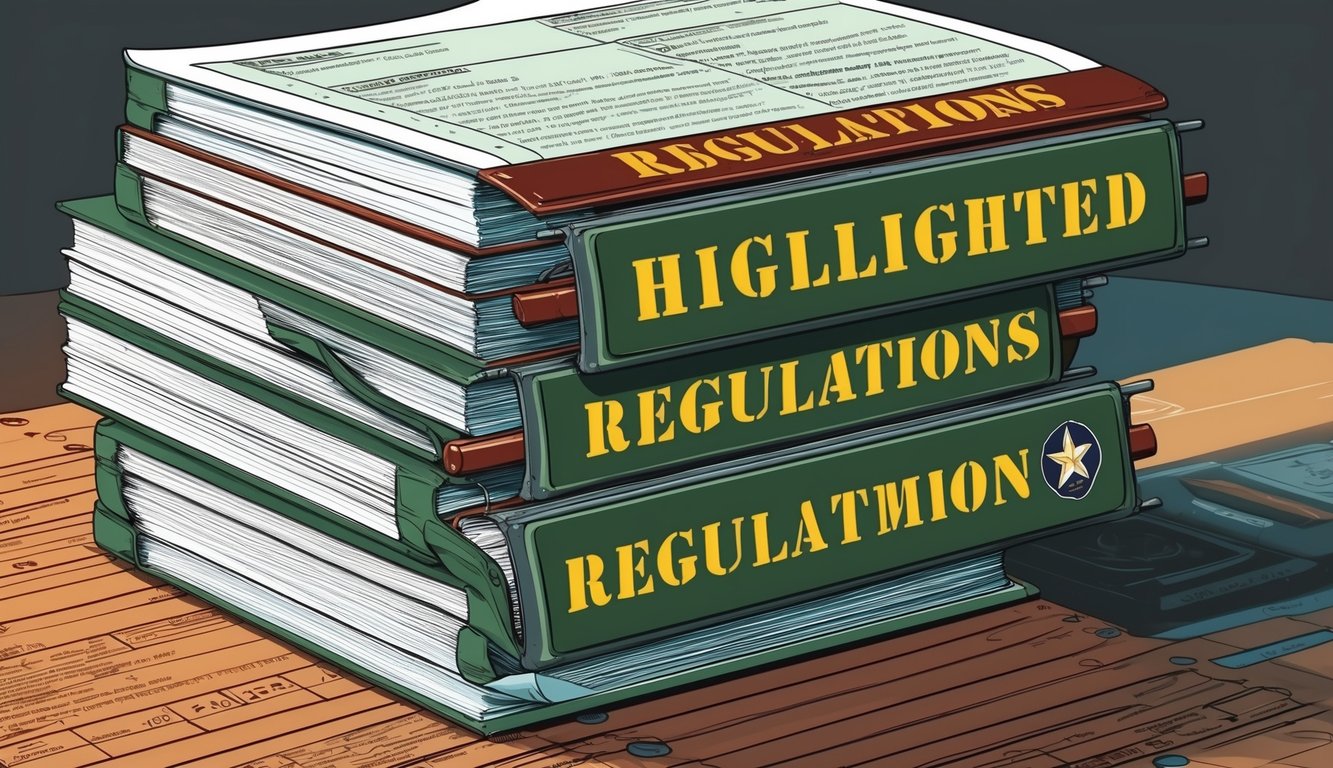AR 25-50 serves as the U.S. Army’s essential manual for drafting and managing official correspondence.
This regulation promotes uniformity and professionalism in Army communications, encompassing everything from memo structures to digital signatures.
Whether you are a newcomer or an experienced officer, grasping AR 25-50 is vital for successfully navigating the complexities of Army documentation.
Ever questioned the uniform appearance of Army documents? AR 25-50 is the answer.
It establishes standards for fonts, date formats, and the correct usage of suspense dates.
By adhering to these guidelines, you actively contribute to a system that ensures the Army operates seamlessly.
Key Takeaways
- AR 25-50 standardizes the formats and procedures for Army correspondence.
- It provides direction on digital signatures, security markings, and records management.
- Familiarity with this regulation enhances your communication effectiveness within the Army framework.
Understanding AR 25-50

AR 25-50 is a vital regulation outlining correspondence procedures for the U.S. Army.
It details instructions for preparing and managing different types of military communications.
Purpose and Scope
AR 25-50 functions as the primary resource for all Army personnel regarding official correspondence.
Its aim is to unify communication practices throughout the organization, covering everything from letter formatting to memorandum structuring.
This regulation applies to all branches of the Army, including the U.S. Army Reserve, and is relevant for both military and civilian personnel engaged in official documentation.
Key areas encompassed include:
- Document formatting
- Writing style and tone
- Signature requirements
- Distribution procedures
Overview of Army Regulation 25-50
AR 25-50 categorizes correspondence into three primary types:
- Letters
- Memorandums
- Messages
Each type has distinct regulations concerning structure, content, and distribution, leading you through the process of addressing recipients correctly, utilizing appropriate letterheads, and properly formatting your text.
The regulation further discusses:
- The use of abbreviations and acronyms
- Accurate reference citation
- Management of classified information
By adhering to these guidelines, you ensure your communications are clear, professional, and aligned with Army standards.
Background of Military Correspondence Policies
Military correspondence policies have significantly evolved over time, with the necessity for standardized communication emerging as the Army expanded in size and complexity.
The early iterations of AR 25-50 can be traced back several decades, and each modification refines the regulations to keep pace with evolving technologies and communication demands.
Key milestones include:
- 1988: Major revisions to accommodate word processing
- 2002: Updates addressing electronic communication
- 2020: Latest version incorporating contemporary digital practices
These policies work to uphold the Army’s commitment to clear, concise, and effective communication, facilitating smooth information flow across the chain of command and various units.
Preparing Army Correspondence

AR 25-50 stipulates essential requirements for creating effective Army correspondence.
Proper preparation ensures clarity, professionalism, and security in official communications.
General Guidelines
Adherence to AR 25-50 is crucial when crafting Army correspondence.
Utilize clear and concise language, and remain focused on the topic.
Organize your thoughts logically before writing and double-check all facts and figures for accuracy.
Address your correspondence to the correct recipient using their proper title and office.
Include a clear subject line summarizing the main topic.
Employ standard Army abbreviations and acronyms, but spell them out upon first use.
Carefully proofread to detect any errors.
It’s advisable to have a colleague review significant documents before sending.
Ensure you meet deadlines for time-sensitive correspondence.
Writing Style and Tone
Your writing should be straightforward and professional.
Use active voice and strong verbs.
Keep sentences concise and focused.
Eschew jargon, clichés, and overly complex terminology.
Maintain a respectful, courteous tone, even when addressing challenging topics.
Be assertive without being arrogant.
Avoid emotive language or personal attacks.
Engage directly with the reader using “you” and “your.” Write in the first person (“I” or “we”) when sharing opinions or accepting responsibility for actions.
Adapt your writing style according to your audience and purpose.
A memo for staff may be more informal than a communication directed at senior leadership.
Formatting and Standard Formats
AR 25-50 delineates standard formatting for various types of Army correspondence:
- Memorandums
- Letters
- Messages
Utilize the correct letterhead, margins, font, and spacing as prescribed in the regulation.
Ensure all necessary elements like date, office symbol, and signature block are included.
Organize content into short paragraphs and bulleted lists for easier readability.
Use bold or italics sparingly for emphasis and number pages for documents exceeding one page.
Be sure to follow specific formatting guidelines for each type of correspondence; for instance, memorandums utilize block format, while letters employ modified block format.
Security Considerations
Safeguard sensitive information within your correspondence.
Clearly mark classified documents with the appropriate classification level and employ suitable cover sheets and envelopes for transmission.
Be cognizant of what information can be transmitted via email as opposed to more secure methods.
Refrain from discussing classified topics over unsecured phone lines or in public venues.
Properly dispose of drafts or copies of sensitive documents once they are no longer needed and report any potential security breaches or lost documents immediately.
Consider utilizing encryption for sensitive digital communications and verify the security clearance of all recipients before sharing classified information.
Components of Correspondence

Army correspondence comprises several key elements that ensure clarity and professionalism, aiding in effectively structuring your letters and memoranda for easy comprehension.
Elements of a Letter
When composing a letter, you must include specific components.
Start with the letterhead, which contains your organization’s details.
Next, add the date, followed by the recipient’s address.
Include a subject line that succinctly summarizes the letter’s intent.
The body of your letter should kick off with an opening paragraph stating the primary point, followed by supporting details in subsequent paragraphs.
Each paragraph should concentrate on a single idea.
Conclude your letter with a closing paragraph that recapitulates or urges action.
Don’t forget to add a complimentary close, such as “Sincerely,” along with your signature block.
Memorandum Structures
Memorandums, or memos, have a structure distinct from letters.
They typically commence with the word “MEMORANDUM FOR,” followed by the recipient’s title or office.
Include the date and a “SUBJECT:” line.
The body of your memo should be succinct and direct, starting with the most crucial information.
Employ short paragraphs and bullet points to break up text and underscore key points.
Unlike letters, memos do not require a complimentary close; simply end with your signature block after the final paragraph.
Signature Block and Distribution
Your signature block is critical for both letters and memos, containing your name, rank, and title.
For official correspondence, sign above your typed name.
The distribution list specifies who should receive copies of your document.
Use “CF:” (courtesy furnish) for those receiving informational copies and list action recipients directly under the signature block.
In electronic correspondence, you can use “/s/” before your typed name to indicate a digital signature.
Remember to adjust your distribution method based on the information’s sensitivity and the recipients’ preferences.
Managing Official Correspondence

AR 25-50 outlines critical procedures for overseeing Army correspondence.
You must adhere to specific guidelines regarding record keeping, privacy protection, and document distribution.
Record Keeping and Privacy
It’s vital to maintain accurate records when managing official correspondence.
Establish a filing system to organize messages by date, topic, or sender.
Retain both digital and physical copies where appropriate.
Protect sensitive information by applying proper classification markings and restricting access to confidential documents.
Securely shred or delete outdated materials.
Be mindful of privacy regulations; do not share personal information without authorization, and use encrypted channels for transmitting sensitive data.
Distribution and Printing
Distribute correspondence efficiently by employing email for routine matters and sending significant documents via registered mail or secure courier.
Limit printing to reduce costs, utilizing double-sided printing when possible, and consider digital distribution rather than hard copies.
Adhere to formatting guidelines for official letterhead and memos, utilizing standard fonts and margins, while ensuring correct signature blocks and office symbols.
Review distribution lists meticulously, sending documents solely to necessary recipients, and utilizing “cc” and “bcc” appropriately to manage information flow.
Effective Communication in the Army
Clear, concise communication is essential for mission success in the Army.
You’ll need to master both written and verbal skills to effectively relay information up and down the chain of command.
Principles of Effective Writing
When composing written communication in the Army, aim for simplicity and directness.
Utilize active voice and concrete language, while avoiding jargon or overly complex terms.
Specificity and context are critical.
Structure your thoughts logically, commencing with the main point or conclusion, followed by supporting details organized by importance.
Utilize short sentences and paragraphs, breaking text with headings, lists, and white space.
This enhances readability and facilitates quick access to vital information for readers.
Always consider your audience, tailoring your writing style and detail level as needed; a brief for senior leaders will differ from technical directions for soldiers.
Editing and Reviewing
Never present your initial draft.
Allow time for review and refinement of your work.
Reading it aloud can help identify awkward phrasing or errors that may go unnoticed on-screen.
Employ tools like spell check, but do not overly rely on them, as they may miss critical mistakes or fail to ensure clarity in your message.
Invite a colleague to review important documents; fresh eyes can often spot issues you’ve overlooked.
Be receptive to feedback and open to revisions.
Double-check all facts, figures, and citations.
Accuracy is paramount in Army communication, as minor errors can lead to significant ramifications.
Remember, effective editing extends beyond grammar to emphasize clarity, conciseness, and impact.
Does your writing fulfill its intended purpose? Could you convey the same information more efficiently?
Regulation Compliance and Best Practices

AR 25-50 establishes crucial guidelines for Army correspondence.
By familiarizing yourself with this regulation and implementing its best practices, you can enhance your communication skills and ensure compliance.
Study and Research
Invest time in thoroughly reading AR 25-50, concentrating on key sections like formatting requirements, writing style, and proper military term usage.
The latest version is available on the Army Publishing Directorate website.
Participate in training sessions or workshops on AR 25-50 if offered, as these can provide valuable insights and practical examples.
Consider developing a quick reference guide highlighting the most frequently encountered rules and formats in your daily work.
Stay informed about any amendments or updates to AR 25-50, as the Army periodically revises regulations to bolster efficiency and clarity.
Adhering to Regulations
Consistency is crucial when applying AR 25-50.
Always use the specified formats for memos, letters, and other correspondence types.
Pay close attention to details such as margins, font size, and spacing, as these seemingly minor aspects contribute to the overall professionalism of your documents.
Employ the correct letterhead and signature blocks as dictated by the regulation, as these vary based on your position and the correspondence type.
Thoroughly proofread your work; errors in spelling, grammar, or formatting can detract from your message and reflect poorly on your attention to detail.
Utilizing AR 25-50 in the Army National Guard
As a member of the Army National Guard, you will apply AR 25-50 for both state and federal correspondence.
Be mindful of any state-specific guidelines that may complement the regulation.
Familiarize yourself with your unit’s chain of command and routing procedures to guarantee efficient correspondence delivery to the right individuals.
When corresponding with civilian agencies or officials, follow AR 25-50’s directives regarding addressing non-military recipients to uphold professionalism in external communications.
Consider developing templates for frequently used document types, facilitating time savings and consistency across your unit’s correspondence.
Extra Resources

AR 25-50 offers a wealth of information, but additional resources can deepen your understanding and application of Army correspondence standards.
These materials deliver practical guidance and supplementary tools to bolster your writing efforts.
Army Correspondence Guide and PDFs
The Army Publishing Directorate website features the official AR 25-50 PDF, allowing you to download this comprehensive guide for detailed instructions on preparing and managing correspondence.
The U.S. Army Garrisons also provide a downloadable version of AR 25-50, which includes specifics on routing communications and maintaining writing quality.
For quick reference, visit ArmyWriter.com for memorandum templates and examples.
These templates can expedite your memo drafting process, offering fill-in sections for efficiency.
Supplementary Websites
The Office of the Administrative Assistant to the Secretary of the Army website (www.oaa.army.mil) presents updates and clarifications concerning AR 25-50.
Here, you can find recent revisions and changes to the regulation’s propoency.
ArmyWriter.com is a valuable resource for various Army writing tasks.
In addition to memo templates, you can access letter formats and other writing aids tailored to military correspondence needs.
These websites offer user-friendly interfaces, simplifying navigation and helping you locate specific guidance for your Army writing tasks.
Department of the Army Correspondence Procedures
Army Regulation 25-50 delineates the procedures for preparing and managing correspondence within the Department of the Army, fostering consistency and professionalism across all communications.
When composing Army correspondence, you will generally use one of three formats: letter, memorandum, or message.
Each possesses specific layouts and rules.
For memos, begin with the standard letterhead, including the office symbol, date, and “MEMORANDUM FOR” line.
Maintain brief paragraphs that get to the point.
Letters are more formal and serve for external communication.
They require a full signature block and appropriate complimentary closure.
Messages provide a means for rapid communication, characterized by brevity and adherence to specific formats with numbered subject lines and paragraphs for easy reference.
Remember to employ plain language and active voice in your writing, avoiding jargon and unnecessarily complex terms.
Key components to include in Army correspondence consist of:
- Office symbol
- Date
- Subject line
- Signature block
- Page numbers (if the document exceeds one page)
Always meticulously proofread your documents prior to sending them off; attention to detail is vital in Army communications.
Frequently Asked Questions
AR 25-50 offers indispensable guidance for Army correspondence, and the following common inquiries address essential aspects of formatting, templates, and specific document types.
How do I format official correspondence according to AR 25-50?
AR 25-50 details precise formatting requirements for Army correspondence.
Maintain 1-inch margins on all document sides, utilizing Arial or Times New Roman fonts in size 12.
Single-space the body text and double-space between paragraphs.
In letters, include the sender’s address, the date, and the recipient’s address at the top.
Provide a subject line and proper salutation, concluding with a complimentary close and signature block.
Where can I find the latest AR 25-50 templates?
Access current AR 25-50 templates through official Army websites.
The Army Publishing Directorate (APD) website hosts downloadable templates, and your unit’s administrative office may also supply approved templates.
Always use the most up-to-date versions to ensure compliance with current standards.
What are the margin and font size requirements for Army documents in AR 25-50?
AR 25-50 specifies a margin of 1 inch on all document sides.
Employ either Arial or Times New Roman font in size 12 for the main text, ensuring readability and maintaining a professional appearance across Army correspondence.
Headers and footers may utilize smaller font sizes where necessary.
Which publication provides guidelines for Army writing and correspondence apart from AR 25-50?
DA Pamphlet 600-67, “Effective Writing for Army Leaders,” complements AR 25-50 by offering guidance on clear and concise writing for various Army documents.
This publication emphasizes writing style, organization, and effective communication techniques.
Utilize both AR 25-50 and DA Pam 600-67 to enhance your Army writing skills.
How are emails handled under the regulations of AR 25-50?
AR 25-50 incorporates guidelines for official email correspondence.
Use a clear, descriptive subject line, starting with a greeting and concluding with a signature block.
Maintain a professional and courteous tone.
Avoid capitalization of all letters, excessive punctuation, or informal language, and proofread before sending to ensure accuracy and clarity.
What is the correct procedure for preparing a military memorandum as prescribed in AR 25-50?
To prepare a military memorandum, commence with the official letterhead.
Center the word “MEMORANDUM” at the top, then include the office symbol, date, and “FOR” line with recipient information.
Add a “SUBJECT” line summarizing the memo’s content.
Number paragraphs for clarity and conclude with the authorizing official’s signature block.

